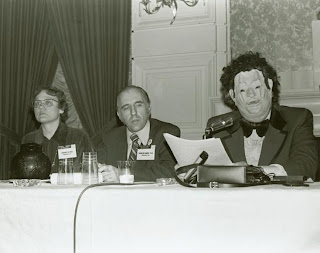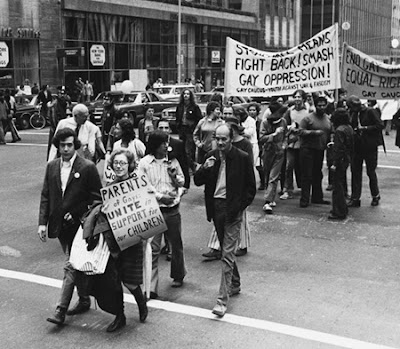The Arrival of AIDS
In the early eighties rumors started circulating among gay New Yorkers of a new "gay cancer." Larry Kramer (pictured below) wrote editorial letters to the New York Native, a gay New York newspaper, begging gay men to be wary of what he thought might be a sexually transmitted illness. In August 1981, he invited about eighty gay men to his apartment, where Friedman-Kien presented statistics about the rising number of what was then the unknown sickness HIV/AIDS. Six months later, Kramer and his friends started Gay Men's Health Crisis, an organization that would one day become the leading AIDS services organization in the country.
Initially there was very little knowledge on what the disease actually was. Described as a rare form of cancer, the Centers for Disease Control dubbed the sickness GRID (Gay-Related Immune Deficiency) in 1981. GRID was shortly renamed to AIDS (Acquired Immune Deficiency Syndrome) in 1982 after heterosexual hemophiliacs, drug addicts, and Haitians.
There were numerous conflicting ideas on the origin of AIDS. Initially doctors thought AIDS might be the culmination of too many STDs or drug usage. Other ideas grew as well: a psychologist in San Francisco published articles suggesting AIDS was from psychological issues as a child. Some tabloids declared it was a curse,while others simply tried there best to stop themselves from getting infected. Finally in 1984 the National Institute of Health found the "probably cause" of AIDS to be a virus called HTLV-III.
What is AIDS? AIDS is a breakdown of the body's immune system, leaving the body vulnerable to any number of infections that would be harmless to a healthy person. AIDS is caused by the HIV virus, which can be found in bodily fluids such as blood and semen, and it is most often transmitted in three ways: unprotected sex, sharing used needles, and being born from an HIV-positive mother. Since its naming in 1982, AIDS has exploded and affected all parts of the world.
AIDS and Bathhouses
The speed at which AIDS was spread throughout the gay community was alarming. Bathhouses only helped to catalyze this speed. Gay bathhouses have been a fixture of American cities since the early 1900s, and the sexual revolution of the 1970s only further their existence. Baths often included dance music, alcohol, drugs, anonymous sex, and group orgies. At the time gay men didn't even consider using condoms-- they had no risk of pregnancy and most of the time getting an STD could be removed by a quick trip to the doctor.
In 1983 gay activist Larry Littlejohn, former president of the Society for Individual Rights (SIR), concluded that the promiscuity at gay bathhouses was expediting the speed at which AIDS was being spreed. Littlejohn began campaigning to have the city close bathhouses down, however he found much unexpected backlash from the gay community. Littlejohn and his supporters came to be largely hated by the gay community, some even suggesting the removal of bathhouses was the next step toward forced concentration camps for gay men.
After a drawn out political fight with the gay community, city public health director Mervyn Silverman closed the baths in October 1984. In New York baths were closed down in 1985 though many still protested. Gay activist Larry Kramer later remember, "Oh God, the battle over whether or not to close the baths became such a red herring because of this issue of sexual freedom. It took all our energy, and it took all our fighting. It shouldn't have been an issue, period.
Stigma: AIDS = Gay
Because of the correlation between homosexuality and AIDS, in 1983 the FDA began excluding men who had or have sex with other men. Views on this were conflicted; many felt that the act saved lives and was a precaution while other felt it was restricting LGBTQ rights. Admittedly, the decision had a positive effect. All blood began being tested for HIV and while then getting an HIV infection from blood was one in 2,500, it is now less than one in a million.
Meanwhile, the federal government did little to help the plight of gay men. Although the CDC had labeled it an epidemic in 1981, President Ronald Reagan ignored the disease. In fact, Reagan didn't even say the word "AIDS" publicly until 1986 and his first major speech on the subject was in 1987 (when more than 21,000 people had already died from it). Secretary Margaret Heckler (pictured below at a conference about AIDS) refused to ask for more funding suggesting that they had everything under control. In reality researchers for a cure for AIDS had to beg, borrow, and steal from other programs to advance research efforts. Congress was thus forced to pass laws to force the federal government to direct more funding towards AIDS research.

Many Christian evangelicals with influence didn't help things for the gay community. Rev. Jerry Falwell, founder of the Moral Majority political action group believed that gay men deserved to die from AIDS. Pat Buchanan, Regan's communications director, stated that AIDS was "nature's revenge on gay men." Soon North Carolina Senator Jesse Helms amended a bill to prohibit AIDS education efforts that encouraged or promoted homosexual activity. This effectively stopped organizations from explaining safe sex to gay men. There were people in government who fought for education on AIDS, however with little funding and support their efforts were largely in vain.
Additional/Relevant Reading:
The History of AIDS -- http://fohn.net/history-of-aids/
Gay America: Struggle for Equality -- Linas Alsenas, pg. 108-121
Finding Out: An Introduction to LGBT Studies -- Meem, Gibson, Alexander, pg. 96-99



























